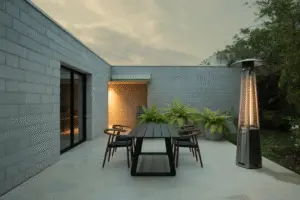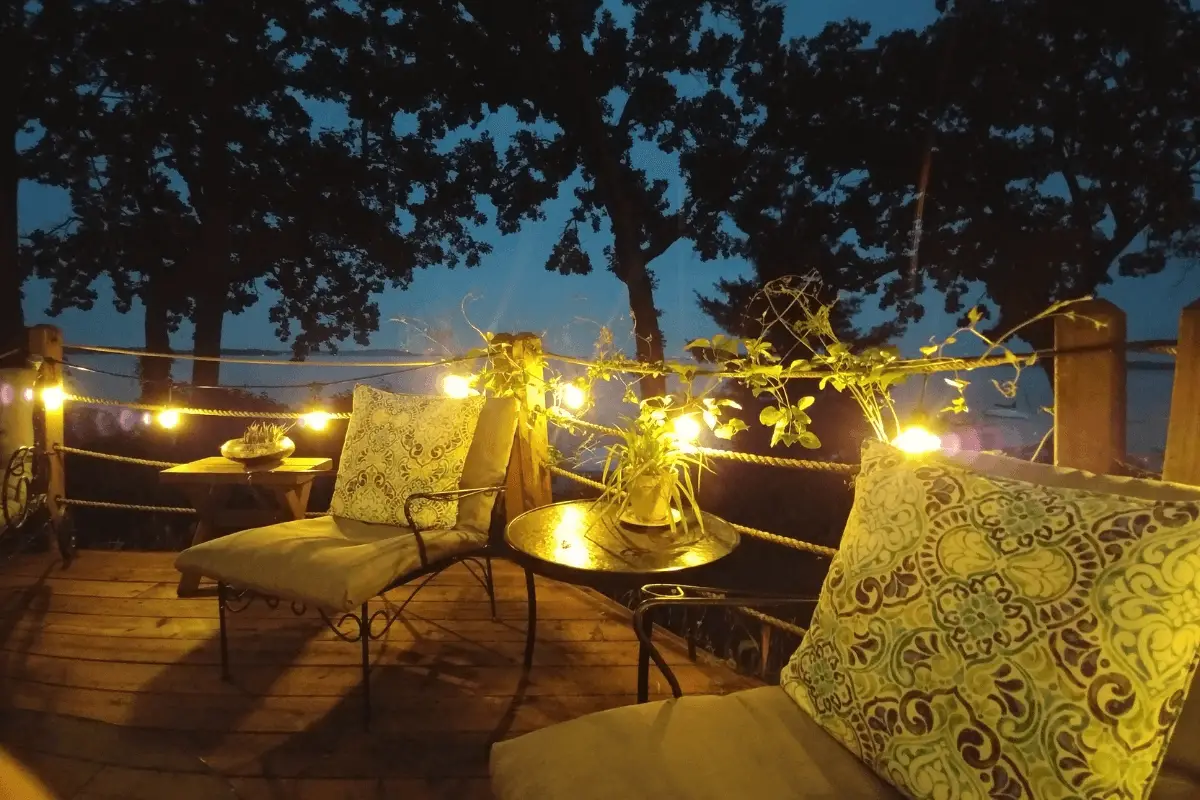Movie dates are a great way to get to know someone and have an old fashioned romantic encounter. However, imagine if you could have that but from the comfort of your backyard. How amazing is that? Well, more and more people are embracing the concept of outdoor home cinemas.
The good thing about having a backyard cinema is that you can customize it however you want. From a full-fledged theater with a big outdoor screen and speakers to just a simple silver screen and projector.
Regardless of your budget, you can create a backyard cinema and turn your space into a movie getaway heaven.
What’s needed in order to create a backyard cinema.
Common questions you might have are:
- How can you get started?
- Isn’t the whole concept expensive and time-consuming?
- What if my yard is too small?
- What are some of the equipment I need?
Don’t worry; in this article, we will take you through everything you need to know about creating a backyard cinema, from how to select the perfect location to all the equipment you need to have. You will be surprised at how easy and affordable the whole process is.
* We may earn commissions on some links *
Table of Content
Add a header to begin generating the table of contents
How to Pick the Perfect Spot

Location is everything. You have to pick the right spot to set up your backyard movie theater. The place you pick will be influenced by your garden’s shape, size, and outlook and whether you want a permanent or temporary setup.
Suppose you are looking to have a place for occasional movie nights; you don’t need to make many adjustments to your backyard. Your existing patio will do.
Just move a few patio furniture to create some space and find the perfect spot to hang your silver screen, and that it. However, suppose you want a more permanent cinema that can be utilized at a moment’s notice. In that case, you have to dedicate a specific area that allows you to secure your screen, audio and visual equipment, seating, and heating.
Keep in mind things such as the size of the screen you wish to use and the number of people you hope to accommodate. Those are just some of the general guidelines. However, we have some more specific pointers that can help you pick the right spot.
Go for a place that is dry and not exposed to wind
Since you will be dealing with electronics, the first thing you need to do is select a dry and sheltered place from the wind.
Avoid brightly lit locations
Also, avoid areas exposed to street lights or bright indoor lights since they might reflect the screen.

The topography of your backyard
Consider all the strengths and weaknesses of your backyard. For example, how flat or uneven is it? If the ground is wobbly, choose the flattest area to install your screen.
The seasons
While some backyard cinemas are meant to be permanent structures, a majority of them a temporary. For instance, I doubt you would be eager to enjoy a movie outdoor during the rainy seasons. To mitigate this, you can try to locate a place with a roof or integrate a carp.
This can also help during those extremely sunny summer days. It is always advisable that you relate to the weather. For instance, if it is approaching winter, you can save a spot for a fire pit or heater.
Access to power outlets
Unless you plan to use a generator for your cinema, you need to set up your theater near a power source. While there are plenty of long electric cables that can be used, they are not very safe and can quickly get damaged.
Equipment you will need
What equipment you will use will depend on your budget and how you want your cinema to look. You can virtually create a backyard cinema with just a silver screen and a projector. However, this will not give you the ideal results.
There are several key items/gadgets that you must have to create the perfect setting, including:
- Projector
- A silver screen or portable screen
- Sound system
- Media player
- Heating
- Seating (cushions, blankets, comfy chairs)
- Other accessories (HDMI, Routers, Extension cords)
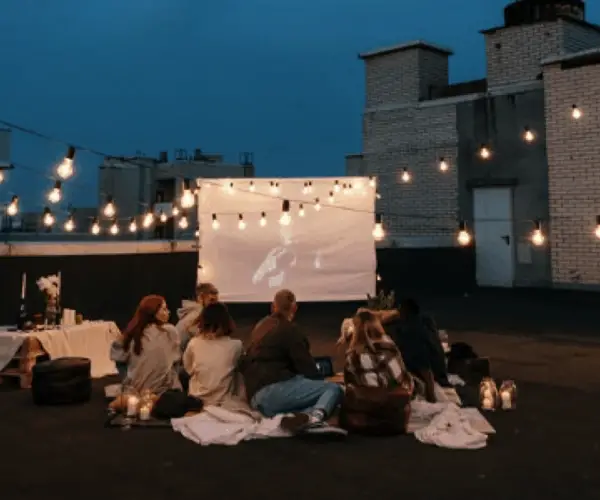
1. Projector
The projector is one of the most critical gadgets, and it plays a significant role in determining how enjoyable your outdoor cinema experience will be. While some of you might be quick to say that you can create a functioning projector out of a shoebox and your iPhone; – we can guarantee you that this will not give you the clarity you might want.
Luckily due to advancements in technology, there are plenty of projectors that range at different prices and are suited for diverse functions. Some are relatively cheap, while others are expensive.
A quick look at Amazon will show you that you can get some for as low as $100 and others going almost $20,000.
So how do you know which is the best projector for you? Here are some of the aspects to look out for.
Resolution
Put, the resolution is the number of pixels (tiny dots) used to display images. Do you plan on just watching movies or playing games? Do you want to go all out and watch in 4k? All these are some of the questions that you should ask yourself.
Keep in mind that the resolution of projectors varies drastically from very low 240p to 4K. For outdoor purposes, you need to go for one with a high resolution. This is because there is a lot of interference when outside, from dust to wind blowing leaves. Also, in most cases, you will be sitting further back from your usual indoor viewing position.
However, for basic use, a projector with a resolution of 1080p should do the job. If your budget is on the lower side, you can still get some quality pictures from non-HD displays. Just ensure you position the screen in a darker place and go for a smaller screen. Non-HD can also save you some bucks, especially if you plan to watch old school movies that were not even produced in HD.
Nonetheless, don’t buy anything less than 720p. Lastly, please don’t go for a 4K projector if you only want to use it for your outdoor cinema. As much as you might want, it is not worth the extra money. Also, not a lot of movies are available in 4K, even in this modern era.

Lumens
Lumens is a unit of measurement used to describe the amount of light emitted by a projector. The projector that you choose doesn’t have to be top-of-the-line; 2,000 lumens should be sufficient. Sorry, we went all nerd on you there.
Don’t let such technicalities scare you. Lumens is just a fancy word for describing brightness. If you plan on using your projector during the day and at night, you might want to invest in one that has more lumens (3,000 to 4,000, to be precise). This is because, during the day, interference from sunlight might affect the display. At night this isn’t much of a problem.
However, as mentioned earlier, remember to avoid setting up your cinema near streetlights or bright indoor lighting. With such specs, you can easily find a projector that costs from around 200-400 USD.
Throw Distance/Ratio
The throw ratio is the distance from your projector to the screen and the screen width in technical terms. Basically, how far the projector can project (throw) the image to the screen. Therefore, it is a significant consideration, and it will affect where you position your cinema.
If you opt for a projector with an incorrect or inadequate throw ratio, you might experience screen over-bleed. As such, if you plan on having a big screen and a larger distance from the projector, you need higher ratios. The general rule for approximating the throw distance is that you need one square foot of screen for every two feet between the projector and the screen.
For example, if the ratio is 2.0, and your screen is about 5-feet wide, your projector should be placed at least 10 feet away from the screen. Sorry, you can’t escape Math even when you want to install a backyard cinema. It might be time to call your 5th-grade teacher. No need for that; play around with the distance before you permanently fix your projector. However, most brands will indicate this ratio.
Input Connections (Adaptors and Ports)
Most people tend to overlook this aspect. However, it is crucial. Projectors don’t all have the same connections, e.g., some have HDMI and others DVI. While most modern Projectors have an HDMI input, it is always better to be sure than sorry.
Other considerations include:
- Sound and built-in speakers. (PS even if they have this feature, in most cases, it’s terrible)
- Size and portability
- Wireless connectivity
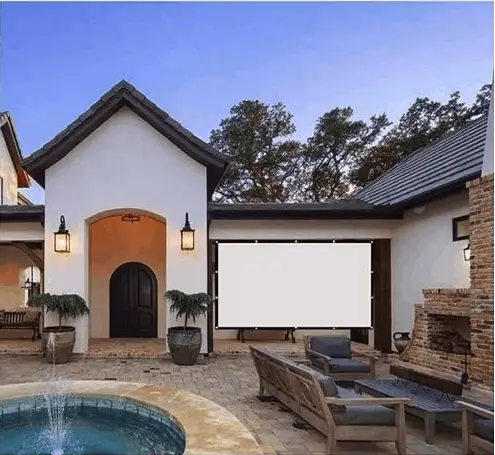
2. Screen
The second most important item. When it comes to the screen, there are plenty of ways to go about it.
- You can buy a silver screen
- Use your wall
- Make your screen
If we are modest, all you need to put a movie screen in your backyard is just a large, light-colored vertical surface with no bumps or irregularities. However, if you have some extra cash and want a more permanent solution, a store-bought outdoor film screen would be ideal. This is because they come in different sizes and forms, from inflatable models to fixed frame ones. The price of most varies around 100 to 200 USD.
However, some can cost up to $1000. These are the more superior and durable options. If you are a homeowner looking to create a permanent outdoor room, then you can consider them.
If you have some time to kill, we would recommend you do a DIY outdoor movie screen. This is very cheap, and it can be a great activity to do with the family. There are endless ways you can go about this, from suspending a white bedsheet/ shower curtain with PVC pipes to going all out and carpeting a wooden frame and mounting a vinyl projector screen on it.
Some other creative methods of making your own screen include:
- Using a cheap blackout curtain, and point the white side (backside) towards the projector
- Painting a large artist’s canvas white
- Tape butcher paper to a wall
- If your wall is even, you can paint it white and point the projector in that direction.
3. Sound system
As we had hinted earlier, even though some projectors come with inbuilt speakers, most of them are not good enough. Most of them have a 10W speaker, which is not sufficient for indoor use, let alone outdoors. Thus you have to invest in an external sound solution.
We can all agree that sound plays a crucial role in creating that cinematic ambiance. Just as is the case with projectors, the options you have are endless. The speaker you go for will depend on the space you need to cover. However, it is always advisable to go for bigger ones since you can always turn down the volume.
Some of the best options you can go for include.
- Soundbars- Soundbar speakers, can enhance your sound output by providing incredible sound quality in different rugged designs.
- Digital AV preamp- You can maximize the soundbar quality with an AV preamp. This gadget will act as a control center to process your outdoor audio.
- Bluetooth speakers- You can even use portable Bluetooth speakers that you already have.

4. Media Player
Now that you have already invested in a projector, a good sound system and a screen- what are you going to watch? Or better yet, how are you going to watch it? You might choose to go old school and opt for a DVD player or Blu-ray player. However, since most modern projectors come equipped with HDMI ports, you don’t have to stress connecting your old DVD player.
You can use your laptop or you can invest in a streaming stick, which has become quite popular. These devices connect directly to the HDMI input on the projector, draw power from the projector’s USB connection, and stream movies using a wireless connection (Wi-Fi).
This feature is only available in modern projectors. However, always ensure that your projector has a powered USB port. This is because while some older projectors had USB ports, they cannot provide enough power for streaming sticks. Therefore, the best bet is to use your laptop.
5. Easy to forget gadgets
It is easy to forget some small but essential gadgets when you are purchasing your equipment. Some key ones include
- Extension Cords
- HDMI cable
- Internet router
- Insect repellant
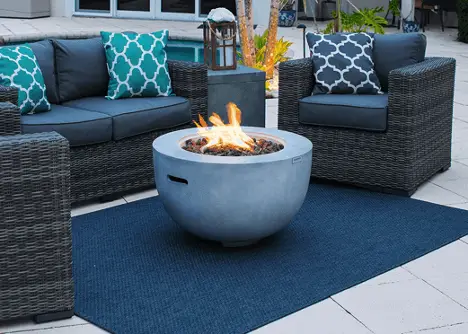
6. Seating
Your backyard cinema will be a place where you relax and have a good time. Therefore, it is only right that you make it as comfy as you can. The seating arrangement you choose will largely depend on your budget and the number of people using the cinema.
If you have an existing patio, it can be the ideal place to set up seating space. Just place the screen near the patio, add some lawn chairs or bench chairs, some few blankets and pillows, and you are good to go.
In case you don’t have a patio, you can take full advantage of a grass lawn. Just spread some sheets, blankets, and pillows for the kids and maybe add some of your lawn or camping furniture for the adults.
This is not only cost-effective, but it also gives you the liberty to set-up your cinema anywhere you want. Lastly, for a more cinematic feel, you can also choose to go for theater-style seats. However, we only recommend this if you have a more permanent structure that is well secured.
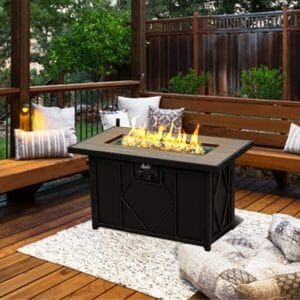
Accessorizing your space
It’s now time to give your backyard theater that WOOW effect. There are a few things that you can do to take your cinema a notch higher.
Add a fire pit (heating)
No one wants to stay out at night watching a movie when it is cold. You must add a source of heat. To have a more luxurious and homey feel, we recommend you go for a fire pit. Fire pits are classy and sleek and will make the space warmer and make it look amazing.
Nonetheless, two different types of fire pit those that use wood and those that use propane or natural gas. Since this is a backyard cinema, you should opt for a gas fire pit. They are less prone to accidents, easy to control the flame, and can be designed to complement your cinema’s outlook.
While wood fire pits provide a more natural flame and are great for firing up those marshmallows, they are not ideal for outdoor cinemas. This is because they produce smoke, which not only affects your viewing but also damages your gadgets.
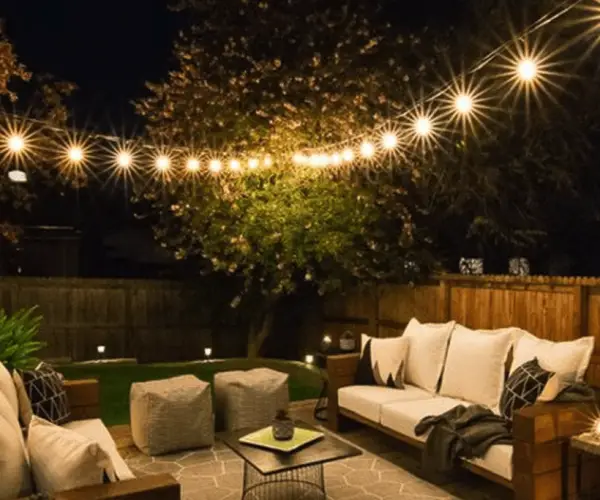
Lighting is everything
Proper lighting can make your garden cinema more enchanting. For example, to guide your guests, you can dot lanterns and tea light holders along the pathway and the walls. This not only looks beautiful but can also keep the insects away. Just burn citronella candles in them, and they will do the trick.
Vintage looking outdoor lights such as lanterns and fairly lights also look spectacular. I am sure you are already picturing that romantic movie date with your partner right now.

Show off your garden
Don’t hold back on plants and flowers. You can include some planted flowers close to the seating area. A few pots of lavender placed along the bottom of the cinema will look amazing.
How to create a theater-like experience
Now that you have everything set-up, there are still a few things that you can do to give your cinema an authentic theater-like feel.
This will be the small things that you see in every movie theater. For instance, if you have an outdoor kitchen, you can add a counter-top hot dog machine. This will help create an authentic concession stand experience for your guests or family.
What is a movie night without popcorn? There are plenty of freestanding and counter-top popcorn machines available in the market, and they won’t cost you a lot. Lastly, you can buy snack-size bags of peanuts, pretzels, or candy and use them to serve your popcorn. I doubt you’ll be going to buy some overpriced popcorns at IMAX now.
Safety Precautions
No one wants to set-up their backyard cinema and have it ruined the next day. Or worse, cause an accident. Thus it would be best if you considered some safety precautions. Such as;
- Always turn off the sprinkles or choose a dry location.
- Avoid any paddling pools.
- Keep the cables out of reach from children. Also, secure them away from your guests’ feet.
- Avoid looking directly in the light from the projector lens.
- In most cases, projector lamps heat up over the duration of viewing. While the internal fans may help cool it down, you always recommend that you let the projector cool entirely before you unplug it.
Get Going
It might just be the ideal time to create that fantastic spot that you and your family can retreat at the end of the day and create memorable moments with the world-changing.
Setting up a backyard cinema is not that complicated, and anyone can do it regardless of your budget, available space, or even DIY skills. It’s that simple! The great thing about this is that you have a lot of ways to approach the whole activity.
Even if you only have the funds to afford a projector, you can still make it work with a few ingenious tips discussed above. We hope that our article was helpful and it will kick start your backyard theater experience.






